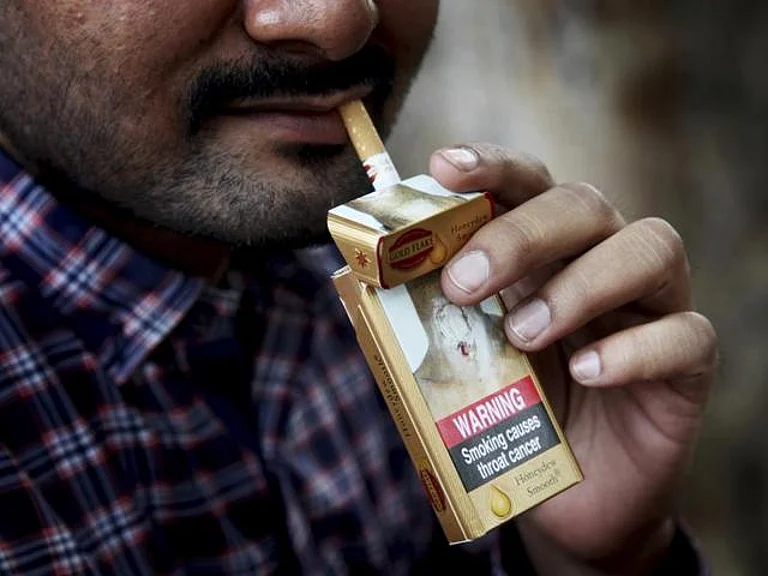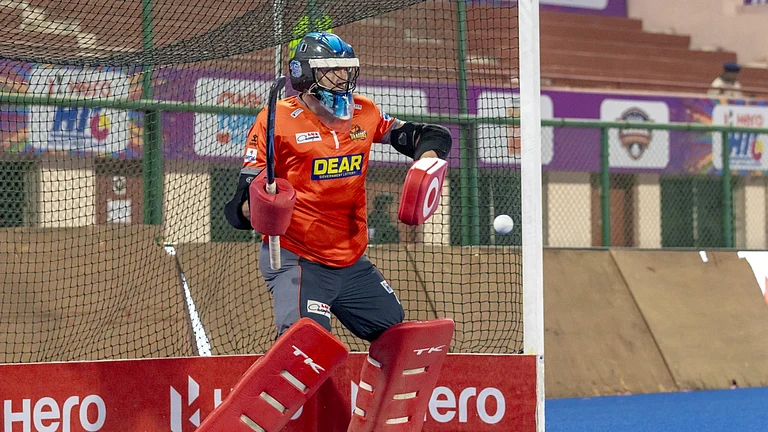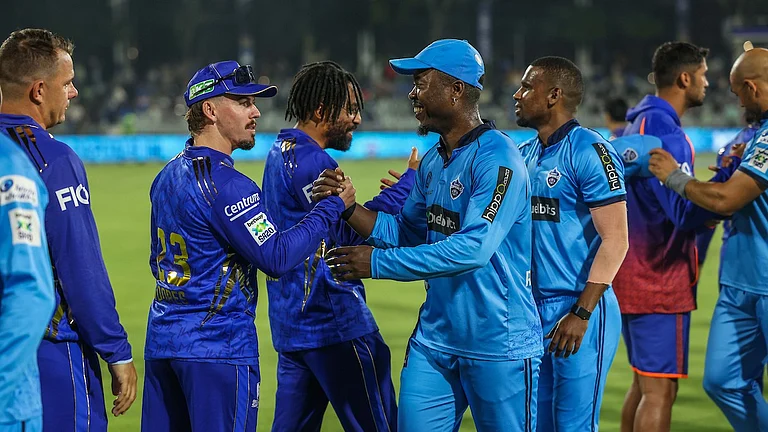This is India’s shameful secret, as it is the world’s. The ‘formal’ economy—where human toil and its fruits are counted and put on graphs—has always had an area of darkness. A very large area that it pretends doesn’t exist. “Women hold up half the sky,” goes the revolutionary phrase. What it really means is that they till and sow and tend to half of earth, toiling just as hard as men—if not actually more. We wouldn’t know. No one has really counted. It’s invisible labour, just like slavery was. ‘Invisibilisation’ doesn’t mean no one can see women working—we see it all the time. The classic image of paddy sowing is rows of women, ankle deep in mud, bent over, working all day, giving birth to our food. Tropes abound.
Women walking miles with pots of water on the head in the arid north Indian plains. Women threshing and winnowing. All of it the subject of art and folk music. Hindi cinema even has a woman with a plough, brow dripping with sweat, as one of its iconic images. But neither Mother India nor traditional songs about Krishna teasing women while they fetch water from the Yamuna changes the way our mind is set: we think of the ‘kisan’ as a man, just like the ‘jawan’. In common metaphor, in calculations of wages and the GDP, in thinking legally about who owns the earth, we erase the daughters of the earth. It is here, after we extract the fruits of her labour, that we make her invisible.
ALSO READ: The Invisible Farmers
It is, in reality, a collective gender crime of unquantified proportions. All of us are guilty of it. A sign that even the higher judiciary was not immune to this common perception came the other day. “Why are women and elders (being) kept in the protests?” Chief Justice S.A. Bobde had occasion to ask, while adjudicating on the ongoing farm protests on January 11. The phrasing there, as media reports were quick to note, implied two things. Women being ‘kept’ at protest sites evokes an image of automatons devoid of will and agency. Being clubbed with ‘elders’ makes of them weak, invalid dependents. ‘Let the women go and the men can sort out this matter’, as a way of thinking, belongs to a time when women were chattel. Not real people with views or stakes.

Stakes? That’s where Indian society and law, still steeped in patriarchy, exacts its real toll. Women’s stakes are deemed to be in the emotional realm, given over for the well-being of family, part of their dharma. Nothing material is ever to be demanded by them, in return for work. That’s only for men. Our landscape is littered with examples of this collective larceny.

Protests in Amritsar against the new farm laws saw massive paricipation of women farmers.
Take Harminder Kaur, a woman farmer of Punjab, the same land from where the farm protestors are streaming out asking for their due share. Life came to standstill for her when she lost her husband two years ago. She was just 28 then. With two children in tow, Harminder had to return to her ancestral house in Bhatinda as her in-laws threw her out even before the last rites were over. Harminder has no land in her name though she had toiled along with her husband since her marriage in 2005. Fourteen years of hard labour, yet she could not ask for her due.
“From sowing to cutting the crop, I used to spend hours on our land. Most of the work was done by me,” says Harminder. Now fighting for her share with the help of an NGO, she is unsure about the outcome. Back at her natal house, it’s more work. She cultivates wheat and pulses, but again, no stakes. She’s aware that she is not entitled to the land she tills. “I don’t want to claim land from my father as I fear it will strain our relationship. I have no idea what to do next,” says Harminder.
She’s only among uncounted lakhs of women farmers in India who remain on the fringes of the formal economy, with no land ownership. Sukhwinder Kaur, state committee member of the Bharatiya Kisan Union (Krantikari), Punjab, knows it all too well. She has been fighting for land ownership for women for decades, and it’s not some abstract ideal for her. The challenge is as personal as it is social and political. Sukhwinder doesn’t have a land title, but the 53-year-old’s life revolves around the 10-acre land owned by her husband. “Right to property is the most pressing issue for women farmers. A daughter may get the land only after her father’s death and the wife gets only after her husband’s death, if at all. We practically have no rights,” she says. This is true of a majority of India’s women farmers—they simply aren’t included in the definition of a ‘farmer’. That’s a very material issue: despite the law taking baby-steps towards a more inclusive notion, at a practical level only landowners are considered farmers.

Protests in Delhi's Singhu border against the new farm laws saw massive paricipation of women farmers.
The Periodic Labour Force Survey 2017-18 (PLFS) says 73.2 per cent of rural women workers are engaged in agriculture in India, but women own only 12.8 per cent of landholdings. “The majority of even those are widows, to whom ownership passed after their spouse’s death,” says Anu Verma of Gujarat-based Maldhari Rural Action Group (MARAG). “It’s very important to delineate the identity of the farmer and bring land into the equation. Land is at the core of everything. Our experience is that it’s a struggle for women to get property inheritance, leaving aside a few widows.” ‘Land to the tiller’ was a slogan central to the last century’s peasant struggles. Every study report shows us that essential inequality continues—in gendered ways. Women had long taken over the task of cultivating the family landholding, as a SEWA study found in Bihar, a state that sees near-perennial migration of the male workforce and hence would offer a good case-study of what they call the ‘feminisation of agriculture’. And yet, no ownership. So they are not real ‘farmers’.
Kavitha Kuruganti, who’s associated with the Alliance for Sustainable and Holistic Agriculture (ASHA), rues how women farmer’s contribution is obliterated. “We see a huge disparity in land ownership. The definition of a farmer is linked to land ownership, and patriarchal notions about who is a farmer control that. That leaves women out of the very concept or definition,” she says. Only gender-disaggregated data will clear the real picture, she adds. That will also bring out other complications—categories besides widows, like divorcees, or abandoned wives.
Take Sunita Choudhary, from Nawada village in western UP. Life rolled some tricky dice for her three years ago when her husband ‘went missing’…with the Rs 3 lakh they had earned from that year’s harvest. The 45-year old now struggles to repay the mounting debts. Her daily schedule starts at 4 am and stretches till 8 at night. “My husband mortgaged the land to someone. Whatever I earn from the crop, I have to pay back to the moneylenders,” says Sunita. And yes, she has no entitlement over the land—she’s not a ‘farmer’ legally! There’s plenty labour, and plenty dignity in that labour, backing Sunita when she says it’s about time things changed.
This awareness is growing gradually. Usha, 49, has been farming in her village in UP’s Hapur for the past 30 years. She says women work harder than men in the fields, especially in labour-intensive processes. Sowing, tilling, winnowing, harvesting, Usha is hands-on like her peers. But despite the multiple roles women play, discrimination is stark, she says—especially on account of a misperception that heavy lifting on farms is done by men. “A bunch of sugarcane comes to around 80-90 kg. It’s the women who cut it. Still, we aren’t considered equals. The government should make it mandatory that land titles be written jointly to include women,” she says. Sashi, also from Nawada, knows the word ‘farmer’ only evokes a picture of “a man toiling in the field”.
“The popular imagination of a ‘kisan’ is that of a male. But the irony is that the work is done by females. It’s the man who gets the kisan credit card, subsidy, all that. Unless we are acknowledged, and get access to technology and government schemes, women will remain unseen,” she says.
The political consciousness is still quite new. When Sulekha Singh of ActionAid undertook a project piloted by Oxfam among UP’s women farmers in 2011, she was taken aback by how much the gender bias was internalised by women. “None of the women were ready to identify themselves as farmers. They said that though 70 per cent work is done by them, it’s the men who are in charge. The entrenched patriarchy and its connection with land runs deep,” says Singh. There’s a visible change now, she says, especially after bouts of training she helps impart on technical and other aspects of farming. “Now women have started questioning. They know what to cultivate, they know the crop. We give them meticulous training, which empowers them. But the real change will happen only when the government starts recognising women as farmers. It must move all PM Kisan payments into the accounts of women farmers after expanding the scheme to all farmers with or without land ownership,” she says.
To be sure, a more comprehensive and inclusive definition came in 2007, with the Centre’s National Policy for Farmers. This document defined a ‘farmer’ as “a person actively engaged in the economic and/or livelihood activity of growing crops and producing another primary agricultural commodity and will include all agricultural operational holders, cultivators, agricultural labourers, sharecroppers, tenants, poultry and livestock rearers, fishers, beekeepers, gardeners, pastoralists, non-corporate planters and planting labourers, as well as persons engaged in various farming-related occupations such as sericulture, vermiculture and agro-forestry.” But for all the fine words, nothing changed on the ground, say women farmers.
Prof Abhijit Sen, agriculture expert and former Planning Commission member, says the “contribution of women in agriculture and rural economy is pretty high, though there’s a section that believes in denying the value of women’s role in the farm sector”. Denial adds to the vagueness. There’s no proper estimation of which particular sphere in farming women contribute more towards—it also varies according to region, crop and socio-economic conditions. At a minimum, as a rule, it’s certainly over one-third and, in some cases, around two-third. In a ‘normal’ scenario, where everyone sticks to prescribed gender roles, anywhere between 33 per cent and 50 per cent of all of India’s farm work is done by women.
Add to that household work, including cooking and tending to the elderly and children. That generally means women work up to 10-12 hours a day while men work around 8-9 hours a day, says Sen.
Around 90 per cent of farmers in our country have small- or medium-sized landholdings. This necessitates working extra on others’ fields or in allied sectors to supplement incomes. No one has a problem counting women here, when there’s work to be done. “They work on their own farms and also in the fields of other farmers, and also do backyard farming and non-farm activities,” says agroeconomist P.S.M. Rao. The problem comes only when paying for that labour—women’s farm labour earns them lesser wages than men. Rao feels it’s a calculated denial. “If you take into account their multiple roles at home, on the farm and allied activities, women’s share would be equal to if not more than that of men,” he says.
The Farm Widow
This is a story by itself. One invisible face of India’s agrarian crisis is the widow of the farmer who dies by suicide. The latter are a well-known category—even if it’s a tale of despair, everyone has at least heard it. But no one ever talks of, or thinks about, how life has crafted anew out of that bleakness by the widows they leave behind. Especially because only a few of them even manage to get the land title transferred to their names, say activists.
E. Rajeswari, of Talapula village in Ananthapur district, is only 28, but has already seen all sides of life in a dozen-odd years. She got married at age 16, back in the unified Andhra Pradesh of 2003, and plunged headlong into cultivating on the four acres owned by her father-in-law. The acuteness of the Deccan’s farm crisis soon caught up with them and her husband killed himself in 2016, after he failed to pay back a Rs 4 lakh loan to moneylenders. Rajeswary neither got ownership of the land nor any government assistance. She now works as a dailywage labourer to fend for her four-member family, including two children. “Earlier I used to work on my farm. Now I work on other’s farms to make a living,” she says, simply.
The National Crime Records Bureau records a total of 10,281 farmer suicides in just 2019. And a study by the Mahila Kisan Adhikar Manch (MAKAAM) shows that 40 per cent of women widowed due to suicides over 2012-18 did not receive rights to their farmland. This is besides their other struggles, the social stigma and harassment from moneylenders. N. Ademma, one such farm widow, works as a farm labourer. Her land is untenable for farming, “but the moneylenders are trying to grab it from me since I am unable to repay the loan my husband had taken. My son dropped out of school,” she says. But she says women have learned to overcome the challenges.
Not all farming women, though. Bhanuja, who works with Rythu Swarajya Vedika, an umbrella association of farm NGOs, says women farmers too end their lives in despair, though there’s no accurate data on the phenomenon. “Usually women farmer suicides are reported as matters of domestic violence and such like, since women are not recognised as farmers,” she says. Bhanuja also says availing compensation due to a widow is a cumbersome process as they need to produce a slew of documents. “The land ownership laws for women remain on paper,” she says. There are indeed rules stipulated for inheritance. The Hindu Succession Act (HSA) says land has to be divided among the widow, the mother and the children of the deceased. Muslim women, under personal law, get one-third of the share in the property (men are entitled to two-thirds)—though, in some states, that doesn’t include agricultural land. And Christian widows are entitled to one-third of the property; the remainder being divided among the children.
But you guess right. More often than not, patriarchy and social norms win over legal rights. Says Bhanuja: “If, say, the land is not registered in the name of the husband and is still in the name of the father-in-law, it’s up to the latter….” The usual script can then be imagined. In Maharashtra, says Pratibha Shinde of Lok Sangharsh Morcha, land rights are mostly observed in the breach. “Sometimes an alcoholic husband will sell off the land without informing the wife. Under the Forest Rights Act, both husband and wife have equal rights. We want the same in agricultural lands too,” says Shinde.
The agrarian crisis is further invisibilising the role of women, says Seema Kulkarni of MAKAAM. “We are seeing that a lot more unpaid work is being done by women because of the agrarian distress. Farmer suicides also put a lot of stress on women; they’re forced to work without any kind of claim to the resources,” she says. Dalit women remain the most marginal, adds Kulkarni. “Even data is not available on Dalit women farmers.” And tribal women farmers remain cut off from the government schemes meant for them, while they do hardly remain untouched by the larger tragedy. When Vaishnavi Samale’s husband died by suicide in 2018, he left a huge debt for his wife to repay. The family’s 3.5 acres, in Maharashtra’s Parbhani district, is in the name of her mother-in-law. Vaishnavi cultivates soybean and cotton there, but has no access to government schemes or markets to sell her produce. “I work as a farm labourer as I have two school-going children to look after,” she says.
Y.K. Alagh, agroeconomist and former minister, says women’s participation in certain farm activities is as high as 70 per cent. This is more so in the case of Dalits and Adivasis. In many cases, Adivasi women play the very key role of decision-makers, especially where menfolk have migrated in search of wage employment. “These women play a very important economic role, yet our system, including the judiciary, does not recognise their contribution. While the law recognises women farmers’ rights to own land, in practice there’s little attempt to enforce the law,” says Alagh. In Meghalaya’s matrilineal tribal societies, part of that equation is inverted. Since it is the women who have property rights, the men, devoid of any personal stake, are popularly seen to be less than enthusiastic about work. Gambling and alcoholism are common. Indeed, even in rural Uttarakhand, the trope of the ‘lazy man’, given over to leisure, is a common one. Women never get any off-days anywhere.
Land’s Caste
The balance is particularly tilted against Dalits, says Paramjit Kaur, a land rights activist from Punjab. According to the 2011 census, 71 per cent of Dalits work as farm labourers, while they own only an abysmal nine per cent of farmland. “No wonder Dalit women are the most exploited. The dominant caste landowners expect them to sleep with them. Sexual harassment is rampant,” she says. Kaur recounts many women breaking down, talking about their bitter experiences, during a land rights movement she was part of. Consequent to that, Dalit women now jointly tend to common land along with other families. “In two villages in Sangrur district, we have taken up a contract for farming in women’s name. We have started a system where women share all farm responsibilities,” she says. Raj Kaur, a 38-year-old farm labourer from Sangrur, is a beneficiary of that movement. “Our dominant caste landlords would harass us while we worked in their fields. Now there’s a huge difference,” says Kaur.
Claiming their rightful stakes, making decisions, forming associations…this is a future worth striving for. Kanchanben Ranshi, 54, owns 10 bighas in her native Ahmedabad district, Gujarat. She has been associated with the community-based organisation Sanand Mahila Vikas Sangthan for the past 20 years. She says she is in charge of the entire process—from deciding the seed to marketing and selling. “Women spend most of their time on the land and work harder than men. If we are not considered farmers, who else will be?” she asks. Ushaben, an Adivasi farmer in Gujarat’s Narmada district, too is an inspiration to her villagers. Associated with the Navjeevan Aadivasi Mahila Vikas Manch, she helps women farmers claim land rights—over 500 women have benefited till now. “Earlier, I didn’t even know a woman could own land. There was a perception that a girl would anyway be married off. Why should she need land when her husband already owns a plot? When I started speaking about the issue, I got quite a lot of backlash. But I was not discouraged. Our Constitution says girls and boys are equally eligible to inherit land,” she asks.
Bridging the gender gap can yield significant results, as a 2011 UN report indicated. Under its group farming initiative in Kerala, the women’s self-help group Kudumbashree was able to bring around 28,500 hectares under cultivation. “Kudumbashree acquires barren land. Loans are facilitated through cooperative banks. We ensure huge participation of women,” says All India Kisan Sabha vice-president S.K. Preeja, who is also a block panchayat president.
The ‘feminisation’ of agriculture as a result of growing rural-to-urban migration by men became a point of debate after the Economic Survey of 2017-18. The vital presence of women in multiple roles—as cultivators, entrepreneurs and labourers—is now beginning to be recognised, says economist Renana Jhabvala, chairperson of SEWA Bharat. “In the case of small farms, especially where men opt to work in factories, the transport sector etc, women do the farming on the family landholding,” she says. However, NSSO surveys show a decline in employment in agriculture for women. There’s plenty regional variation. “In some pockets, there is feminisation—for instance, in Uttarakhand and Himachal. But, overall, there also seems to be a trend towards defeminisaton in counted numbers,” says Kuruganti. The picture is also cloudy due to the overall transitions in play. For instance, an increased focus on cash crops impacts women’s relationship with agriculture, says Ishan Aggarwal of the Foundation for Ecological Security, which works in Madhya Pradesh. Women tend to possess traditional knowledge on crop varieties and seeds, so changing farm practices affect that. At a time when farm laws are a national debate, and rights and their denial are finally being talked about, and Indian agriculture looks towards a saner tomorrow, this is a darkened corner of the field that must finally come into light.
***

Woman with a Rain Gun
N. Parameswari, Tamil Nadu
N. Parameswari became a farmer only after her marriage. “I used to help out initially in the fields, but now I manage all the farming activities full time. My husband, Natesan, takes care of our powerloom business,” says this woman farmer from Kollapatti village in Namakkal district of Tamil Nadu. She now grows cane and groundnut, and it is the latter she finds both challenging and interesting. The groundnut crop is usually rain-fed and requires more preparation before the rains arrive. This demands weeks of soil conditioning in the four acres used to cultivate groundnut. Since Parameswari, 48, switched to organic farming 12 years ago, groundnut farming has become even more taxing, she says. “But the result is equally good as we get a bountiful crop that is healthy in every way without any trace of chemicals. As we sell only the nuts and not the whole groundnut, there is a huge demand for our crop. At the end of each crop, we earn about Rs 18,600 as profit per acre. Even our groundnut creepers fetch a good price as cattle fodder because they contain no chemicals,” she points out.
As poor rains are bad for groundnut cultivation, Parameswari overcomes the deficit using a local innovation—the rain gun. The 10-feet-tall contraption is essentially an oversized sprinkler that sucks water from a well or borewell and sprays it over a radius of 60-80 feet. It can be moved around to cover the entire field.
When the five-month-long groundnut cultivation season is over, she uses the field for growing red maize, which provides excellent fodder for cattle—her own and those of others. Other than managing these crops and the cane field spread over another 15 acres, Parameswari also tends to half-a-dozen milch cows owned by her family.
Asked if women farmers like her face any difficulty, she says: “Once everyone sees our involvement and willingness to put in long hours in the field, they show us the same respect that is accorded to male farmers. Even the traders treat us well when they see the healthy produce we have cultivated.”
By G.C. Shekhar in Chennai

Landless and Alone
Mangala Devi, UP
Text and photo: Tribhuvan Tiwari
As the biting cold wind blows in from the north, shaking the morning dew off the sorghum or chari grass grown to feed cattle, 75-year-old Mangala Devi hobbles to the fields with her handy sickle. The widow doesn’t own the land she tills; works for a landowner at Khedi village of Ghaziabad, UP. Says her husband owned two bighas but lost them, she knows not how. She lives alone—her two sons have moved away with their families. “Women work as farmers, but their work is not recognised,” says Devi, who fends for herself when women of her age “lead a comfortable life surrounded by family”. She works the fields three-four hours a day, every day, for her food and supplies; does all the household chores; takes care of a cow she calls her friend.

How Kisan Chachi Broke Taboos
Rajkumari Devi, Bihar
Agriculture has been an all-male preserve especially among the privileged castes in Bihar. But Rajkumari Devi, popularly known as Kisan Chachi, broke the patriarchal glass ceiling in the feudal society by taking to farming at a time when women were not even allowed to venture out of their homes. Married to an unemployed man from a Bhumihar family of Anandpur village in Muzaffarpur district in 1974, Rajkumari realised soon after the wedding that her in-laws expected her to do little besides traditional household chores. But she longed to go out to the agricultural fields—a scandalous aspiration for the daughter-in-law of an orthodox family.

Conferred Padma Shri in 2019, Kisan Chachi says she was drawn to agriculture primarily because of her farmer father, who used to take her to his fields in her childhood. “I was always fascinated by farming,” she adds. In the beginning, even her mother and brother frowned upon her for “working like a man” in the fields in her in-laws’ village. Her husband too was not supportive enough then. Everybody tried to dissuade her—her brother, in fact, promised to send her money every month if she stayed away from the fields. Her father-in-law, miffed with her for having “brought shame to his family”, separated her from their joint family, giving her only three bighas of land. This proved to be a turning point for Rajkumari, now 65. Determined to prove a point to her family, she started growing cash crops like tobacco along with seasonal fruits in the area ravaged by annual floods. She also began making pickles and fruit jam, which found many takers.
Riding a bicycle through muddy lanes, she formed a group of poor women and inspired them to take to farming and cattle-rearing for becoming financially independent. Later, she set up many self-help groups with the help of local officials of the agriculture department. It was not long before she caught the attention of Nitish Kumar when he became CM in 2005. Today she also sells pickles online under the brand name of Kisan Chachi.
By Giridhar Jha

Cash from Compost
Chennamma, Karnataka
At the entrance to Chennamma’s farm, just next to where half a dozen cows graze, is her vermicompost patch. Beneath the layer of dung, wiggling worms are hard at work creating a nutrient-rich mixture—for Chennamma, a farmer from Antharahalli village near Doddaballapura, about 50 km north of Bangalore, they are a lifesaver. Every three months or so, the family sells manure at about Rs 5,000 per tonne, fetching a sum that helps to keep things going. “The returns from selling vermicompost helped to put our two daughters through college,” she says. Chennamma received a best woman farmer award at a Krishi Mela in 2007 and since then has kept a keen eye on progressive farming practices. In her mid-40s now, she and her husband Hanumantharaju C., 52, manage their six-acre farm together.
Chennamma says the worry of raising a family on agricultural income motivated her to attend training sessions conducted by the local Krishi Vigyan Kendra (KVK). Over the years, she has been a resource person for other women farmers as well. “We only buy sugar, coffee and pulses. Everything else we need...vegetables, flowers, fruits...all come from our field,” she says. A few years ago, the KVK recognised her as a success story in cultivating french beans.
Currently, Chennamma is cultivating arecanut, banana, guava and other fruits—longer-term crops that would save the daily trip to the market to sell produce, economise on labour and also get good returns. “Everything has two sides to it, even agriculture. We have burnt our fingers too. But if we farm scientifically and if we find a market for our produce, it will not be too difficult to make a living out of farming,” she says. Her elder daughter Rakshita is studying engineering, while the other daughter, Harshita, is doing a BSc Horticulture course. “We are proud of what our mother has achieved. She has been independent from a young age and has worked hard,” says Rakshita.
By Ajay Sukumaran in Bangalore

Homemaker, Not Farmer
Nikki Tomar, UP
Text and photo: Tribhuvan Tiwari
Like most full-time women farmers, Nikki Tomar is not counted as a farmer...but as a housewife. And like most rural homemakers from a farming family, the 24-year-old mother of two has the twin responsibility of, in her words, homework and fieldwork. She works more than seven hours on the 80-bigha farm, tilling the soil, cultivating, irrigating fields. She has in-laws to take care of, the family’s livestock, her children, husband…cooking, doing the dishes, washing, cleaning and more. “I can ride a bike, and a tractor…I do farming too,” she says. Does she own land or is her work as a cultivator seen as equal to men? She won’t comment. The profound feudal veil stops her, like those many voices of India’s invisible women farmers confined to the margins.


























